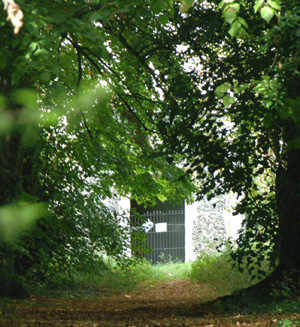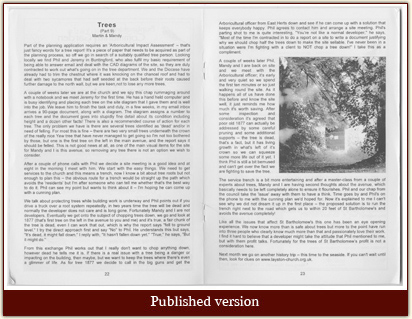Martin & Mandy

Part of the planning application requires an ‘Arboricultural Impact Assessment’ - that’s just fancy words for a tree report! It’s a piece of paper that needs to be acquired as part of the planning process, so off we go in search of a suitably qualified tree person. Looking locally we find Phil & Jeremy in Buntingford, who also fulfil my basic requirement of being able to answer email and deal with the CAD diagrams of the site, so they are duly contracted to work out what’s going on in the tree department. We and the Diocese have already had to trim the chestnut where it was knocking on the chancel roof and had to deal with two sycamores that had self seeded at the back before their roots caused further damage to the north wall, but we are keen not to lose any more trees.
A couple of weeks later we are at the church and we spy this chap rummaging around with a note book and we meet Jeremy for the first time. He has a hand held computer and is busy identifying and placing each tree on the site diagram that I gave them and is well into the job. We leave him to finish the task and duly in a few weeks in my email intray arrives a 90 page document along with a diagram. The diagram assigns a number to each tree and the document goes into stupidly fine detail about it’s condition inc height and a dozen other facts! There is also a recommended course of action for each tree. Only problem we have is there are several trees identified as ‘dead’ and/or in need of felling. For most this is fine - there are two very small trees underneath the crown of the really nice Yew tree that have never managed to get going so I’m not too bothered by those, but one is the first tree on the left in the main avenue,and the report says it should be felled. This is not good news at all, as one of the main visual items for the site for Mandy & I is this Avenue, so removing any tree there is not an option we wish to consider.
 A couple of phone calls later with Phil and we decide a site meeting is a good idea and at eight in the morning I meet with him. We start with the easy things, we need to get services to the church and this means a trench, now I know a bit about tree roots but not enough to plan this - the obvious route for a trench would be straight up the path which avoids the ‘residents’ but I’m after someone who can tell me whether that’s the best way to do it. Phil can see my point but wants to think about it - I’m hoping he can come up with a cunning plan.
A couple of phone calls later with Phil and we decide a site meeting is a good idea and at eight in the morning I meet with him. We start with the easy things, we need to get services to the church and this means a trench, now I know a bit about tree roots but not enough to plan this - the obvious route for a trench would be straight up the path which avoids the ‘residents’ but I’m after someone who can tell me whether that’s the best way to do it. Phil can see my point but wants to think about it - I’m hoping he can come up with a cunning plan.
We talk about protecting trees while building work is underway and Phil points out if you drive a truck over a root system repeatedly in two years time the tree will be dead, normally the developer does not care and is long gone, fortunately Mandy and I are not developers. Eventually we get onto the subject of chopping trees down, we go and look at 1877 (that’s first tree on the left in the avenue to you and me) and it’s true, a fair chunk of the tree is dead, even I can work that out, which is why the report says ‘fell to ground level’. I try the direct approach first and say ‘No’ to Phil, he understands this but says ‘It’s dead, it might fall down’ I reply with ‘It hasn’t fallen down yet’ .. ‘True’ he says ‘But it might do’.
From this exchange Phil works out that I really don’t want to chop anything down, however dead he tells me it is. If there is a real issue with a tree being a danger or impacting on the building, then maybe, but we want to keep the trees where there’s even a glimmer of life. As for tree 1877 we decide to call in the big guns and get the Arboricultural officer from East Herts down and see if he can come up with a solution that keeps everybody happy. Phil agrees to contact him and arrange a site meeting. Phil’s parting shot to me is quite interesting, ‘You’re not like a normal developer’ he says, ‘Most of the time I’m contracted in to do a report on a site to write a document justifying why we should chop half the trees down to make the site sellable. I’ve never been in a situation were I’m fighting with a client to NOT chop a tree down!’. I take this as a compliment.
Couple of weeks later Phil, Mandy and I are back on site and we meet with the Arboricultural officer, it’s early and very quiet so we spend the first ten minutes or so just walking round the site. As it happens all of us have done this before and know the site well, it just reminds me how much it’s worth saving. After some inspection and consideration it’s agreed that poor old 1877 can actually be addressed by some careful pruning and some additional supports - the tree is dead, that’s a fact, but it has living growth in what’s left of it’s crown so we can squeeze some more life out of it yet. I think Phil is still a bit bemused and can’t get over the fact we are fighting to save the tree.
The service trench is a bit more entertaining and after a master class from a couple of experts about trees Mandy and I are having secondthoughts about the avenue which basically needs to be left completely alone to ensure it flourishes. Phil and our chap from the council take the ‘issue’ away with them to have a think. Time goes by and Phil’s on the phone to me with the cunning plan we’d hoped for. Now it’sexplained to me I can’t see why we did not dream it up in the first place - the proposed solution is to run the trench right next to the road which gets us to within 20 feet of St Bartholomew’s and avoids the avenue completely!
Like all the issues that affect St Bartholomew’s this one has been an eye opening experience,we now know more than is safe about trees but more to the point have run into a three people who clearly know much more than that and passionately love their work. I find it hard to believe that a developer might take the attitude that Phil mentioned to me, but with them profit talks. Fortunately for the trees of St Bartholomew’s profit is not consideration here.
 |
|
 |
